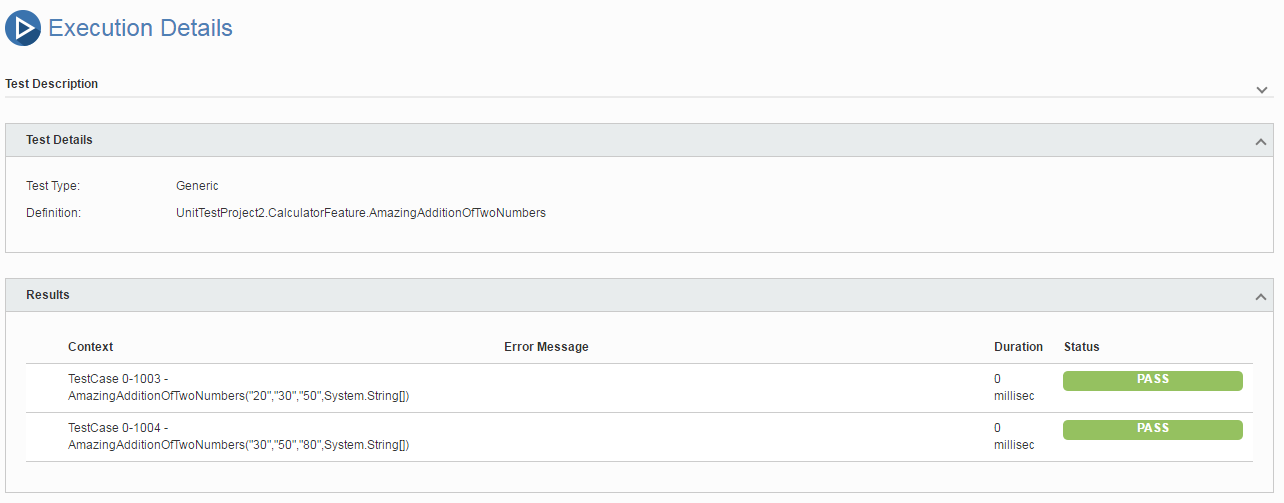Page History
Overview
In this tutorial, we will create a simple Specflow test in C#, using Nunit NUnit as the test runner.
| Info | ||
|---|---|---|
| ||
Although this tutorial explores a way of managing Specflow tests " in JIRA"Jira, it does no not take advantage of Xray's Cucumber features. Therefore, in this case, JIRA Jira isn't used to make the BDD specification; only to abstract the Tests. Tests The tests in JIRA Jira wil be created as Generic Tests and , not Cucumber Tests. This is, since the semantic Since the semantics of Cucumber tests Tests is lost, such are also, for example, so do the Scenario Outline examples-related results. |
...
Description
Specflow is a tool used for BDD in C#.
In this case, we'll start by writing The example, the test case validates a Calculator class and exploits some Nunit NUnit features, such as the ability of validating to validate the same Test against multiple input values, and also the possibility of linking Tests with requirements in JIRA through the usage of Nunit's Jira by using Test attributes.
| Code Block | ||
|---|---|---|
| ||
Feature: Calculator
In order to avoid silly mistakes
As a math idiot
I want to be told the arithmetic operation of two numbers
@mytag
Scenario: Add two numbers
Given I have entered 50 into the calculator
And I have also entered 70 into the calculator
When I press add
Then the result should be 120 on the screen
Scenario: Multiply two numbers
Given I have entered 2 into the calculator
And I have also entered 3 into the calculator
When I press multiply
Then the result should be 6 on the screen
Scenario Outline: Amazing addition of two numbers
Given I have entered <input_1> into the calculator
And I have also entered <input_2> into the calculator
When I press add
Then the result should be <output> on the screen
Examples:
| input_1 | input_2 | output |
| 20 | 30 | 50 |
| 30 | 50 | 80 | |
...
| Code Block | ||||
|---|---|---|---|---|
| ||||
<?xml version="1.0" encoding="utf-8"?> <packages> <package id="NUnit" version="3.6.0" targetFramework="net452" /> <package id="NUnit.Console" version="3.6.0" targetFramework="net452" /> <package id="NUnit.ConsoleRunner" version="3.6.0" targetFramework="net452" /> <package id="NUnit.Extension.NUnitProjectLoader" version="3.5.0" targetFramework="net452" /> <package id="NUnit.Extension.NUnitV2Driver" version="3.6.0" targetFramework="net452" /> <package id="NUnit.Extension.NUnitV2ResultWriter" version="3.5.0" targetFramework="net452" /> <package id="NUnit.Extension.TeamCityEventListener" version="1.0.2" targetFramework="net452" /> <package id="NUnit.Extension.VSProjectLoader" version="3.5.0" targetFramework="net452" /> <package id="NUnit3TestAdapter" version="3.6.0" targetFramework="net452" /> <package id="Shouldly" version="2.8.2" targetFramework="net452" /> <package id="SpecFlow" version="2.1.0" targetFramework="net452" /> <package id="SpecFlow.NUnit" version="2.1.0" targetFramework="net452" /> </packages> |
After successfully running successfuly the Scenarios and generating the NUnit XML report (e.g. , TestResult.xml), it can be imported to Xray (either by via the REST API or through "the Import Execution Results" action within the Test Execution).
| No Format |
|---|
nunit3-console bin\Debug\UnitTestProject2.dll |
| No Format |
|---|
curl -H "Content-Type: multipart/form-data" -u admin:admin -F "file=@TestResult.xml" "http://localhost:8080/rest/raven/1.0/import/execution/nunit?projectKey=CALC" |
...
NunitNUnit's Test Case is mapped to a Generic Test in JIRAJira, and the "Generic Test Definition" field contains the name of the class, and the method name that implements the Test Case.
The Execution Details of the Generic Test contains information about the Test Suite, which in this case corresponds to the Test Case class.
References
...


